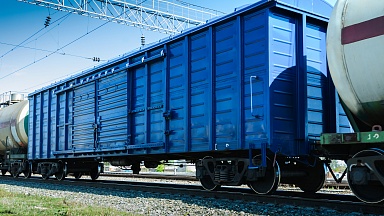Using the software AnyLogic (Version 8), authors give a macroscopic model designed as a GIS-based discrete-event model of rail freight from China to Germany under existing border control point capacities, eventually providing a general overview toward the classification of different routes and countries and later ranking them according to their criticality index. This criticality index is computed as a product of time variance and the Logistics Performance Index. The former is obtained through various scenario analyses within the paradigm of shortest route and current border control points having constant capacity, but variable number of trains per day.
The analysis shows that it is of utmost importance to increase the border control points (BCP) processing capabilities, but more importantly route diversification for efficient traffic management. And in the context of supply chain security, a breakdown of any part of these routes or nodes could cause long and uncertain lead time on either side of the network. However, any node closure in any of the northern corridor countries would cause the longest delay, and when there is no traffic inflow ability in the northern corridor countries (total blackout), the southern corridor countries could provide another favorable alternative.
Authors developed five scenarios that were used to shed light on the best route in the network (shortest path) under current border conditions from China to Germany. In Scenario 1 (China, Kazakhstan, Russia, Belarus, [Lithuania, Kaliningrad], Poland, Germany) under the current conditions of BCPs, the journey time increases as the number of trains increases. However, when the congestion parameter condition is enabled at the European side the journey time decreases significantly.
In Scenario 2 (China, Mongolia, Russia, Belarus, Poland, Germany), the number of trains per day is directly proportional to journey time and we see a bottleneck at the Mongolian BCP. So, in order to develop this route, the capacity of this BCP should be increased.
In Scenario 3 (China, Russia, Belarus, [Lithuania, Kaliningrad], Poland, Germany), we see that relying solely upon the eastern Chinese Suifenhe–Pogranichny BCP the route starts experiencing capacity limitations and significantly longer journey times with increasing number. However, when 50% of the trains are diverted to the other Chinese–Russian BCP (Manzhouli–Zabaikal’sk), the average journey time varies in the range of 5% (100 trains) to 9% (20 trains). The effect of increasing capacity by opening all BCPs leads to a drastic decrease in overall average journey time.
In Scenario 4, the route connects China to Germany through various Central Asian and Middle East (Iran, Turkey) countries where one possibility is to cross through Iran or bypass it by taking the Caspian Sea. Although the Caspian route is shorter, it does not make much of a difference in terms of the journey time due to intermodal loading and unloading procedures and capacity limits at the seaports.
In Scenario 5, all routes are simultaneously being exploited with and without low LPI regions. In both cases, the average journey time per train increases with number of trains inserted. Greater number of routes (hence more BCPs) leads to greater processing of trains under congestion, resulting in decreased average journey time even under stress. Interestingly, with increasing number of trains the maximum time difference between both cases starts to differ more significantly due to longer distance and capacity constraints. So, expanding the capacity of exiting BCPs is of importance.
Comparing and ranking those scenarios, we see that the first scenario yields the best results in terms of minimum journey time. In this case, the trains can either take only the Belarus–Poland border or both Belarus–Poland border and/or Kaliningrad depending on the queue length; only when there is no queue, trains will opt at Minsk to take the former route to reach Germany.
Authors formed two categories of countries, i.e., southern and northern corridor countries, due to geological, historical, and development reasons. After various iterative experiments of the model, the results yield that Russia, Kazakhstan, Poland, and Belarus are the most important countries in the northern corridor. Looking at the southern corridor, Turkey’s integral role for the passage into Europe becomes apparent. An alternative option through Black Sea (Poti to Constanta) is shorter by distance, but longer in the context of the journey time due to lesser speed of ships (and other intermodal procedures).
There is room for improvement at certain locations like the China–Mongolia border (e.g., Erenhot-Zamiin Udd) as evident in the scenario analysis or Belarus–Poland border (Brest–Małaszewicze). While train speeds are limited by its physical nature, to increase the capacity of goods transfer can be achieved through higher frequency. A higher frequency would mean greater load at BCPs. It is showed in this study that, as the number of trains is increasing in the network, congestion at various nodes is growing.



